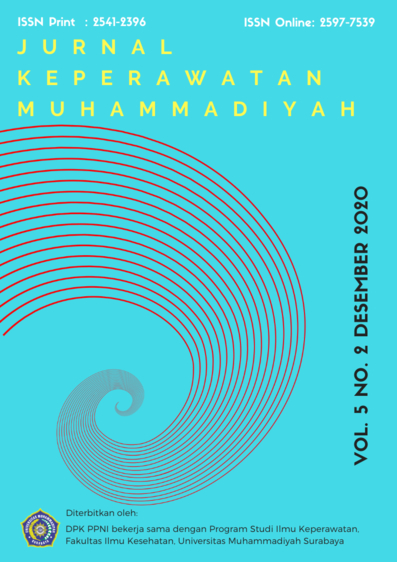Efektifitas Jus Semangka Dan Jus Pepaya Terhadap Penurunan Tekanan Darah Penderita Hipertensi Di Puskesmas Kembaran 1 Banyumas
DOI:
https://doi.org/10.30651/jkm.v5i2.4710Keywords:
Hypertension, Watermelon juice, Papaya juiceAbstract
Objective: Â To determine the effectiveness of watermelon juice and papaya juice on blood pressure in patients with hypertension at the Puskesmas (Public Health Care Center) Kembaran I Banyumas.
Methods: This research uses quantitative methods with a quasi-experimental design with a pre-post group. The sample selection using a purposive sampling technique obtained 15 respondents in the watermelon juice group and 15 respondents in the papaya juice group. The statistical tests used are Paired t-test and independent t-test
Results: The results of the study found that the average systolic blood pressure of the watermelon juice group was from 148.13 in the beginning to 138.93. The average diastolic blood pressure was 85.80 to 80.60. While the average systolic blood pressure of the papaya juice group was from 149.40 in the beginning to 145.67, the average diastolic blood pressure was from 84.20 to 80.80. There were significant differences in systolic and diastolic blood pressure before and after treatment in the watermelon juice and papaya juice groups with p0.05. There is a significant difference in the effectiveness of watermelon juice and papaya juice on the reduction of systolic and diastolic blood pressure with p0.05.
Conclusion: Watermelon juice is more effective than papaya juice for reducing blood pressure in patients with hypertension at the Puskesmas Kembaran 1 Banyumas.
References
Andika, F (2019). Faktor risiko kejadian hipertensi di rumah sakit umum Daerah dr.Zainoel Abidin Provinsi Aceh. Journal of Healthcare Technology and medicine.Vol 5 No 1.
Andriani, A. (2017). Pengaruh pemberian jus pepaya mengkal dalam menurunkan tekanandarah penderita hipertensi. Jurnal Ilmu Keperawatan Stikes Yarsi Sumbar, 11, 299- 311
Anggara Dwi, F H dan Prayitno N. (2013). Faktor-faktor yang berhubungan dengan tekanan darah di Puskesmas Telaga Murni Cikarang Barat. Jakarta: Program Studi Kesehatan Masyarakat STIKES MH. Thamrin. Jurnal Ilmiah Kesehatan. Vol 5. No 1.
Atun, L., Siswati, T., & Kurdanti W. (2014), Asupan Sumber Natrium, Rasio Kalium Natrium, Aktivitas Fisik dan Tekanan Darah Pasien Hipertensi di Puskesmas Sleman, MGMI, Volume 6 nomor 1 tahun 2014, Sleman. Hal.68-69
Brian, J. (2011). Kebugaran dan Kesehatan. Jakarta: Rajawali Pers.
Dinkes Provinsi Jateng. (2018). Profil Kesehatan provinsi Jawa Tengah Tahun 2018. Semarang : Dinkes Provinsi Jawa Tengah
Dinkes kabupaten Banyumas. (2018) Profil Kesehatan Kabupaten Banyumas.
Fitria, A, Sase. (2013). Hubungan Durasi Aktivitas Fisik Dan Asupan Natrium Dengan Tekanan Darah Pada Wanita Monopouse. Universitas Diponegoro Semarang.
Hidayat, A (2009). Metodelogi Penelitian Kebidanan dan Teknik Analisis. Jakarta: Salemba Medika
Jain, R (2011). Pengobatan alternatif untuk mengatasi tekanan darah. Jakarta: PT Gramedia Pustaka Utama.
Kholish, N. (2011). Bebas hipertensi seumur hidup dengan herbal. Yogyakarta:Real Books.
Kementrian Kesehatan Republik Indonesia. (2015). Hipertensi, The Silent Killer. https://pusdatin.kemkes.go.id
Manno, F., Nilawati Soputri., Idauli Simbon. (2016). Efektivitas buah semangka merah (Citrullus Vulgaris Schard) terhadap tekanan darah. Jurnal Skolastik Keperawatan. Vol 2. No 2.
Manurung, W. P., & Wibowo, A. (2016), Pengaruh Konsumsi Semangka (Citrullus vulgaris) untuk Menurunkan Tekanan Darah pada Penderita Hipertensi, Majority, Volume 5 nomor 5 tahun 2016, Lampung. Hal.105
Notoatmodjo,S (2010). Ilmu Perilaku Kesehatan Edisi I. Jakarta: Medika Cipta
Nuraini, N. (2015). Aneka berkhasiat obat. Yogyakarta: Real books.
Olivia. (2014). Semangka kaya akan kalium. (http://www.rumahsehatblogspot.com/2017/11/ manfaat buah semangka. di akses tanggal 26 januari 2019, jam 15.07 WIB).
Puspaningtyas. D.E. 2013. The Miracle of Fruits. Jakarta: Agromedia Pustaka . Riset Kesehatan Dasar. (2018). Hasil Utama Riskesdas 2018.
Sari, R (2017). Pengaruh pemberian jus semangka terhadap penurunan tekanan darah pada lansia penderita hipertensi di wilayah kerja puskesmas Lubuk Buaya Padang Tahun 2017. Jurnal Ilmu Kesehatan.1, 79-86.
Smeltzer, S. C., & Bare, B. G (2015). Buku ajar keperawatan medikal bedah Brunner & Suddarth. (8th ed). Jakarta: EGC.
Sulistyonigsih, H. (2011). Gizi Untuk Ibu dan Anak. Yogyakarta: Graha Ilmu
Sugiharto, A (2007). Faktor-faktor resiko hipertensi Grade II pada Masyarakat.
Downloads
Published
Issue
Section
License
- Penulis tetap memegang hak atas karyanya dan memberikan hak publikasi pertama kepada jurnal ini yang secara simultan karya tersebut dilisensikan di bawah:Â Creative Commons Attribution-ShareAlike 4.0 International (CC BY-SA 4.0)













